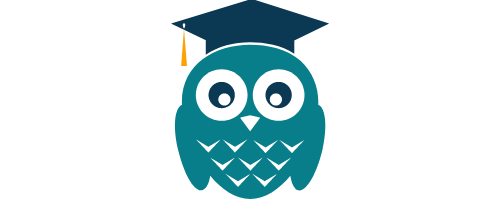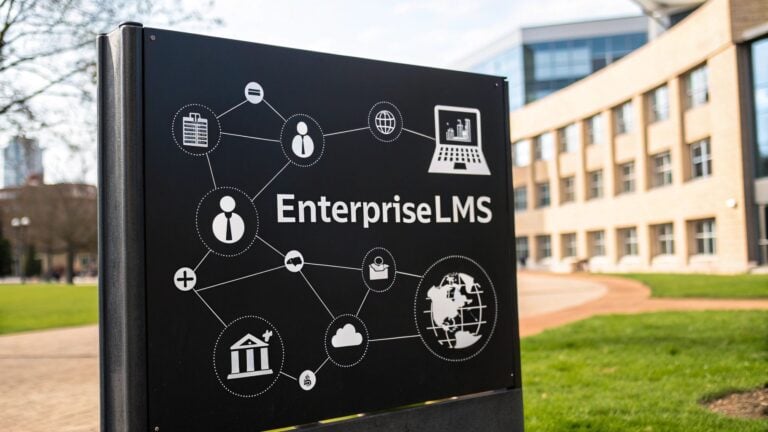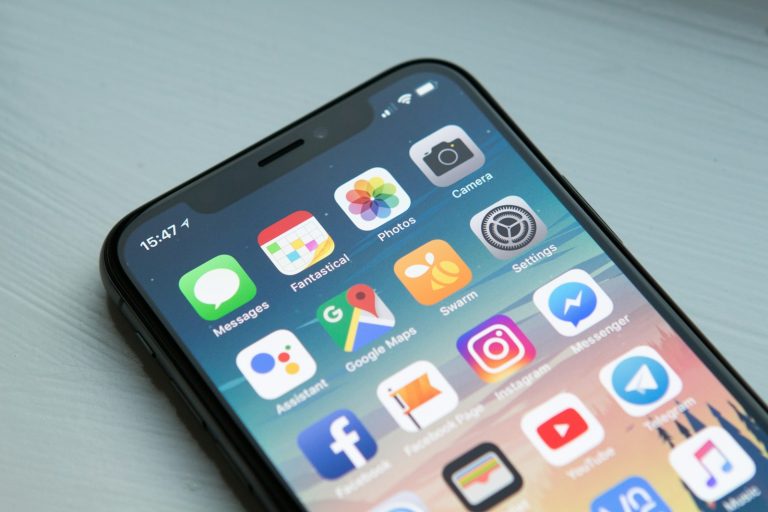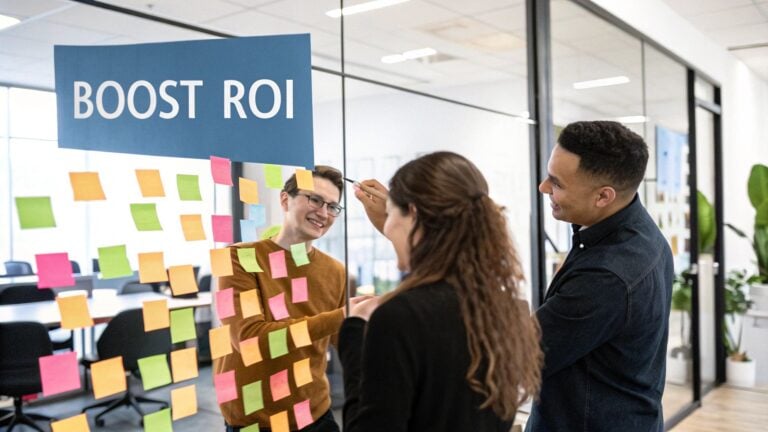How to Write a Curriculum That Truly Connects
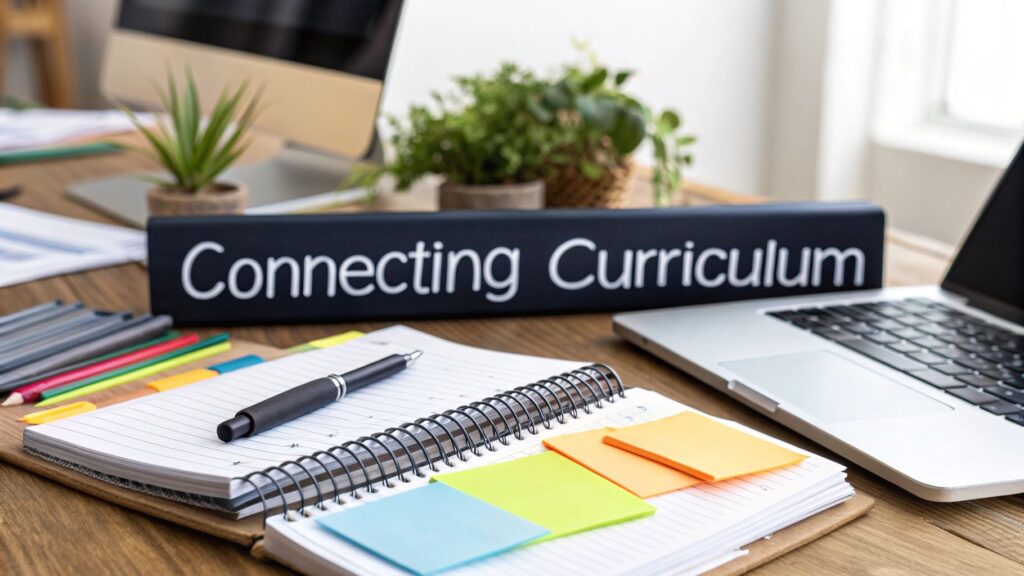
Writing a curriculum is about more than just listing topics. It’s a process of defining your learners’ needs, setting crystal clear objectives, structuring content in a way that makes sense, and building in assessments that actually measure learning. But it all starts with a solid foundation long before you even touch the first lesson plan.
Laying a Strong Foundation for Your Curriculum
Before I even think about writing a single lesson, my first move is always to figure out who I’m teaching and why. This initial phase is all about building a solid foundation, and I can’t overstate how much it simplifies everything that comes later.
I kick things off with what is called a needs analysis. It might sound a bit academic, but it’s really just my process for getting to the heart of the curriculum’s purpose. Why does this course need to exist? What problem is it actually solving for the people taking it?
Getting answers to these questions is non negotiable. You want to create something that doesn’t just look good on paper but delivers real, tangible value.
Identifying the Core Problem
The main goal here is to get a sharp, clear picture of what skills are missing or what knowledge gaps need to be filled. I have a few simple, practical ways to gather this info without getting bogged down in weeks of research.
- Quick Surveys: A simple Google Form sent to potential learners can uncover common pain points in a matter of hours.
- Informal Conversations: Just talking to people in your target audience often provides the most incredible, unfiltered insights.
- Existing Data: If you’re building a course for a company, look at performance reviews or team metrics to spot skill gaps.
The idea is to find the space between where your learners are now and where they need to be. That gap is precisely what your curriculum is designed to fill.
A curriculum without a clear needs analysis is like a map without a destination. You might create a lot of interesting content, but you’ll have no idea if it’s getting anyone where they actually need to go.
This process ensures every piece of your course is intentional. For instance, if I discovered a sales team was great at opening conversations but fumbled when closing deals, I wouldn’t build a curriculum covering the entire sales cycle.
I would focus intensely on negotiation and closing techniques because that is the identified need. This is a key part of our complete guide on how to create a curriculum, which you can explore for more details.
Defining Success From the Start
Once you’ve nailed down the problem, you need to define what success looks like for someone who finishes your program. This goes hand in hand with understanding the need. Is success a promotion? The ability to build a website from scratch? A measurable improvement in a specific business metric?
This foundational step is also where we can look at broader educational trends. Big picture data helps us see where learning gaps are most significant on a larger scale.
For example, a 2025 UNESCO data refresh revealed that globally, 234 million school-aged children need educational support, highlighting a massive need for adaptable and effective curricula. This kind of information shows just how vital it is to address specific learning gaps, whether in a classroom or a corporate setting.
Ultimately, getting this right from the start makes every other step so much easier. You’ll have a clear direction, a defined purpose, and a solid understanding of your learners. And to make sure your final product is polished and impactful, learning how to edit your writing professionally is a skill that will serve you well throughout the entire creation process.
Crafting Clear and Measurable Learning Objectives
Alright, you know who you’re teaching and why they need this course. Now it’s time to get brutally specific about what your learners will actually be able to do when they’re done. This is where we write learning objectives, and frankly, they’re the absolute backbone of your entire curriculum.
Think of them as the promises you make to your students.
Vague goals like “understand social media” or “learn about the topic” are course killers. They’re impossible to measure, they set fuzzy expectations, and they leave everyone guessing what success even looks like.
We have to do better. We need to craft objectives that are crystal clear, specific, and measurable. These objectives become the roadmap for every piece of content, every activity, and every assessment you create from here on out. Get this right, and the rest of the process becomes so much easier.
The Power of Action Verbs
The secret sauce to a killer learning objective is the verb. You have to use action verbs that describe a skill you can actually see someone perform.
Let’s look at a quick before and after. A weak, passive objective might be:
- Know the history of digital marketing.
How do you prove someone “knows” something? It’s a mess. It’s fuzzy. Let’s sharpen it up with an action verb:
- Compare three major digital marketing strategies from the 20th century.
See the difference? The second one is something you can observe. A student can create a chart, write an essay, or give a presentation that directly demonstrates that skill. This shift from passive knowing to active doing is everything.
Examples for Different Learning Levels
Not all learning is created equal. Sometimes you just need someone to remember a key fact. Other times, you need them to wrestle with a complex problem and create something new. Your action verbs should reflect these different levels of thinking.
Here are a few examples to get your gears turning:
- For simple recall: “List the five stages of the project management lifecycle.” or “Define the term ‘user experience’.”
- For comprehension: “Explain the difference between a fixed and a growth mindset.” or “Summarize the key findings of the provided case study.”
- For application: “Construct a basic monthly budget using the provided spreadsheet template.” or “Apply the ‘rule of thirds’ to compose a photograph.”
- For complex problem-solving: “Design a marketing campaign for a new local coffee shop.” or “Critique a business proposal and suggest three areas for improvement.”
Think of your learning objectives as a contract with your learner. You are clearly stating, “If you complete this course, you will be able to do these specific things.” This builds trust and sets clear expectations from day one.
Writing strong objectives isn’t so different from setting good goals in any other part of life. To make sure your objectives are not just clear but also truly actionable, it can be helpful to explore some effective goal-setting frameworks for structure and inspiration.
Ultimately, every single objective you write should tie directly back to the needs analysis you did earlier. Each one should be a puzzle piece that helps solve the core problem you identified. Once you have a solid set of objectives nailed down, organizing your content becomes infinitely more straightforward because you’ve already defined your destination.
Structuring Your Curriculum Scope and Sequence
You’ve got your destination locked in. The learning objectives are crystal clear. Now it’s time to actually draw the map. This phase is all about defining your curriculum’s scope and its sequence.
Think of it this way: scope is everything you’re going to teach, and sequence is the order you’ll teach it in. Nailing this is the difference between a learning path that feels intuitive and one that feels like a jumbled mess.
My process always starts with a massive brain dump. I’ll grab a whiteboard (or just a blank document) and list every single topic, concept, and skill I can think of related to the subject. No bad ideas at this stage. The goal is just to get it all out where I can see it.
Defining What Is Truly Essential
Once that giant list is staring back at me, the real work begins: trimming the fat. I go back to my learning objectives and ask one simple question for every single item on my brainstorm list:
“Does this directly help my learner achieve one of our core objectives?”
If the answer is a firm “yes,” it stays. If it’s a “maybe” or a “not really, but it’s interesting,” it has to go. You have to be ruthless here. One of the most common mistakes I see is cramming way too much information into a curriculum, which just leads to cognitive overload and frustrated students.
This simple flow is the foundation of the whole process.
As you can see, everything from analyzing needs to selecting methods has to point back to those learning objectives. That’s exactly what we’re doing when we define the scope.
Choosing Your Organizational Structure
With your essential topics selected, the next step is figuring out the sequence. How do you organize the content in a way that makes the most sense? There’s no single right answer here. The best structure really depends on your subject matter.
Let’s walk through a few real world scenarios.
Coding Bootcamp: For a technical skill like coding, a simple to complex structure is almost always your best bet. You start with the absolute basics like variables and data types. Then you build up to functions, loops, and eventually, full blown applications. Each lesson has to build on the one before it.
Creative Writing Workshop: Here, you might opt for a thematic structure. One week could be all about character development, the next on plot, and another on dialogue. These topics are distinct yet related, so they can be learned in a more flexible order.
History Course: A chronological structure is the natural choice. You start at the beginning of a time period and move forward through events as they happened. This creates a clear narrative that helps learners understand cause and effect.
Put yourself in your learners’ shoes. How will they best absorb this information? You want to build momentum and create a path that feels like it’s going somewhere. For a deeper dive into laying this out, our guide on how to create a free course outline template has some great frameworks to get you started.
Mapping Topics to Objectives
To make absolutely sure every piece of your content has a purpose, I always create a simple mapping table. It’s a visual gut check that connects the “what” (your content) with the “why” (your objectives).
This keeps you honest and ensures your curriculum is lean and focused. A table like this makes it painfully obvious if a piece of content doesn’t align with any objective, which is a clear signal that it might be unnecessary fluff.
Here’s a quick look at how you can organize this for a beginner photography course.
Mapping Content to Learning Objectives Example
This table shows a simple example of how to align specific curriculum modules with their corresponding learning objectives to ensure all content is purposeful.
| Module/Unit | Learning Objective(s) Addressed | Key Activities/Content |
|---|---|---|
| Module 1 Introduction to Photography | Define the three core elements of the exposure triangle (aperture, shutter speed, ISO). | Video lecture on the exposure triangle. Hands-on camera setting practice. |
| Module 2 Composition Basics | Apply the “rule of thirds” to compose a balanced photograph. | Reading on composition principles. Photo analysis exercise. Peer feedback session. |
| Module 3 Lighting Fundamentals | Differentiate between hard and soft light and their effects on a subject. | Outdoor lighting demonstration. Assignment: “Find the Light.” |
Taking the time to thoughtfully define your scope and sequence creates a curriculum that guides learners on a clear and effective journey from where they are to where they want to be. It’s the blueprint for a great learning experience.
Developing Engaging Content and Activities

Alright, this is where the theory stops and the fun begins. You’ve laid the groundwork, defined your objectives, and mapped out the journey. Now it’s time to bring your curriculum to life with content and activities that actually grab and hold attention.
A great curriculum is so much more than a list of facts to memorize. It’s a series of experiences that spark curiosity and build real, tangible skills.
The goal here is to make learning an active process, not a passive one. You want learners leaning in, thinking critically, and immediately trying to apply what they’ve learned. That means moving beyond simple readings and lectures to create a rich mix of materials and tasks that cater to different ways of learning.
Moving Beyond the Textbook
First things first, let’s talk about the actual “stuff” your learners will interact with. The content you choose must directly support the learning objectives you worked so hard on. Every video, article, or project needs to have a crystal clear purpose tied back to one of those action oriented statements.
Here are a few types of content that work well in a modern curriculum:
- Readings and Articles: These are classics for a reason, but keep them concise and laser focused.
- Videos and Demos: Short, punchy videos are perfect for explaining complex concepts or walking through a process step by step.
- Hands-On Projects: This is where the deep learning happens. Give learners a real problem to solve or something tangible to create.
- Group Discussions and Peer Feedback: Facilitating conversations allows learners to process information out loud and ask clarifying questions.
For crafting content that truly captivates, this practical guide to project-based learning offers some fantastic insights. It’s an excellent way to design experiences that learners remember long after the course is over.
Designing Activities That Make People Think
Once you’ve got your core content, you need to build activities around it. An activity isn’t just busywork. It’s a structured task designed to make learners wrestle with ideas, solve problems, and practice their new skills.
The key is variety. You need a mix of activities that appeal to different learning styles. Some people learn by doing, others by discussing, and some by quiet reflection. A strong curriculum offers a little something for everyone, which is what keeps people hooked from start to finish.
This shift toward application is a massive global trend. We’re seeing a huge move toward skill aligned frameworks that prepare people for the real world, not just for a test.
The global education market is rocketing towards nearly $10 trillion by 2030, and a massive chunk of that growth is focused on skills like digital fluency, creative problem solving, and collaboration.
Finding and Creating Great Materials on a Budget
You don’t need a Hollywood budget to create amazing content. There are tons of fantastic, high quality resources available for free or cheap if you just know where to look.
Here are a few go to strategies for sourcing materials without breaking the bank:
- Embrace Public Domain and Creative Commons. Sites like Unsplash for images or YouTube for educational videos are goldmines of content you can use freely, as long as you follow their specific licensing terms.
- Create Your Own Simple Videos. Seriously, you don’t need a fancy studio. A smartphone with a decent camera, good lighting from a window, and clear audio are all you really need. Tools like Loom or Canva make recording and simple editing a breeze.
- Become a Master Curator. You don’t have to create everything from scratch. A huge part of a curriculum developer’s job is to find the best articles, podcast episodes, and tutorials out there and then build smart activities around them.
The most important thing is that every single piece of content you choose or create is intentional. It has to serve your learning objectives and contribute to a dynamic, engaging experience for your students.
Integrating Meaningful Assessments and Feedback
So, you’ve designed a beautiful curriculum full of engaging content and activities. But here’s the million dollar question: how do you know if it’s actually working?
The answer is meaningful assessment and feedback. These aren’t just tests you tack on at the end of a unit. Think of them as vital diagnostic tools. They tell you whether your learners are truly grasping the material and, just as importantly, where your curriculum is shining and where it needs some serious TLC.
When you think about assessment from the very beginning, you build your entire curriculum on a foundation of measurable results.
Checking for Understanding Along the Way
First up, let’s talk about the two main flavors of assessment. I like to think of them as quick, informal check ins versus the big final exam.
The first type is formative assessment. These are small, low stakes checks you sprinkle throughout the learning journey. Their goal isn’t to assign a grade but to gauge understanding in real time. They’re your early warning system, letting you know if people are getting lost long before the final project is due.
Some of my go to formative assessments include:
- Quick Quizzes: A short, five question multiple choice quiz after a video can quickly show who’s paying attention and who might need to rewatch.
- One-Minute Papers: Ask learners to write for sixty seconds on the most important thing they learned in a lesson.
- Peer Discussions: Having learners explain a concept to each other in a discussion forum is one of the best ways to solidify their learning.
These little checkpoints are essential for building momentum and keeping everyone on the right track. They also help build connection, which is a key part of any good learning experience. You can find more ideas on this in our guide on how to build community in an online course.
Measuring the Final Outcome
The second type is summative assessment. This is the one you’re probably more familiar with. It’s the final project, the big exam, or the capstone presentation. It comes at the end of a module or the entire course and measures overall achievement against your learning objectives.
A good summative assessment should directly ask a learner to perform the skill you outlined in your objective.
For instance, if your objective was, “Design a basic marketing campaign for a local coffee shop,” your summative assessment is simple. You ask them to design that marketing campaign. It’s a project that requires them to pull together everything they’ve learned into a single, practical application.
The best assessments feel less like a test and more like a final performance. They give learners a chance to show off their new skills in a meaningful, practical way.
This focus on practical, accessible learning isn’t just a trend. It’s a global shift. Historically, curriculum design has evolved to prioritize inclusivity and learner centered approaches.
International initiatives have supported better educational access for 372 million children worldwide by creating frameworks that value accessible teaching methods just as much as content.
A Curriculum Is a Living Document
Assessment isn’t just about the learner. It’s also about you and the curriculum itself. Your work isn’t done the moment you launch. In fact, that’s when some of the most important work begins for you as the creator.
A curriculum should be a living, breathing document that you continuously improve over time. The best way to do that is by gathering direct feedback from the people who are actually using it.
Here are a few simple methods I rely on:
- Learner Surveys: At the end of the course, send out a simple survey. Ask what they loved, what was confusing, and what they’d change. Keep it short and sweet to get the highest response rate.
- Performance Data: Dive into the assessment results. Is there one quiz question that almost everyone gets wrong? That’s not a sign your learners are failing. It’s a sign your content on that topic might not be clear enough.
- Direct Conversations: If you can, hop on a quick call with a few learners. Ask them to walk you through their experience. You’ll often uncover powerful insights that you’d never get from a survey.
This feedback loop of teach, assess, refine, repeat is how you take a good curriculum and make it truly great. It’s an ongoing cycle that ensures your content stays relevant, effective, and valuable for every new person who comes through your course.
Frequently Asked Questions About Curriculum Writing
We’ve covered a lot of ground, from the big picture strategy down to the nitty gritty details. Now, I want to tackle a few of the questions that always seem to come up when people are in the thick of this process. Learning how to write a curriculum can feel like a massive undertaking, but breaking it down really helps. I hope these answers give you that extra bit of clarity and confidence you need to get moving.
What Is the Biggest Mistake People Make?
Hands down, the single most common mistake I see is getting swept up in the excitement of a topic and skipping the needs analysis entirely. It’s so easy to do, especially when you’re genuinely passionate about what you’re teaching. The urge to just start creating content can be overwhelming.
But when you skip that foundational step, you’re essentially just guessing. You might build a beautiful, polished course packed with fascinating information, but if it doesn’t solve a real world problem for your specific audience, it’s not going to land.
You absolutely have to start with the “why” before you even touch the “what.”
Always, and I mean always, begin by digging into who your learners are and what gap you’re trying to fill for them. Everything else you build flows directly from that initial understanding.
How Long Should a Curriculum Be?
This is one of those tricky questions because there’s absolutely no magic number. A curriculum should be exactly as long as it needs to be to hit your learning objectives, and not one sentence longer.
The focus must always be on the outcome, not the clock. A short, powerful curriculum that helps a learner master one specific, tangible skill is infinitely more valuable than a long, bloated one that meanders through a bunch of “nice to know” trivia.
Think of it like a recipe. You only include the exact steps needed to make the dish successfully. Anything extra just confuses the cook and can ruin the final product. Your curriculum works the same way.
So, instead of asking, “How many hours should this be?” start asking, “What’s the most direct and efficient path to help my learner achieve these objectives?” Sometimes that path is short and intense. Other times, it requires a longer, more detailed journey. Let the goals dictate the length, not the other way around.
How Do I Make My Curriculum More Inclusive?
This is such an important question. Creating an inclusive curriculum is about so much more than just the words you choose on a page. It’s about intentionally designing a learning experience where every single person feels seen, respected, and capable of succeeding.
It’s a philosophy that should be baked into the very structure of your course from day one. Here are a few practical strategies I always try to keep in mind:
Vary Your Content Formats: Not everyone learns best by reading dense text. Mix it up! Use a combination of text, videos with captions, audio clips, and hands on, interactive activities. This simple shift caters to different learning preferences and accessibility needs.
Offer Multiple Ways to Show Mastery: A single, high stakes final exam isn’t the only way to measure what someone has learned. Give learners options to demonstrate their knowledge through projects, presentations, written reports, or even group collaborations. This flexibility can make a world of difference.
Get Diverse Feedback Early and Often: During your design and review process, go out of your way to get feedback from a diverse group of people. Ask them point blank: “Do you see yourself and your experiences reflected in this material?” Their insights are pure gold for spotting blind spots you would have missed on your own.
Ultimately, building an inclusive curriculum isn’t a one and done checklist item. It’s an ongoing commitment. It’s about being thoughtful, really listening to your audience, and continuously looking for ways to make your learning environment more welcoming and effective for everyone.
